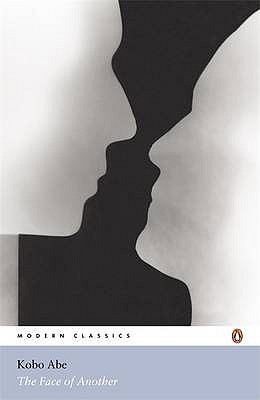2016 review of a book written
by an author whose family name starts with the letter
A B C D E F G H I J K L M N O P Q R S T U V W X Y Z
by an author whose family name starts with the letter
A B C D E F G H I J K L M N O P Q R S T U V W X Y Z
Although the expression isn’t used in all languages with exactly the same meaning as in Japanese, we all feel at once that it can’t be a pleasant experience “to lose your face”. In fact, it uses to be rather embarrassing, if not shameful because the person concerned inadvertently disappoints expectations, violates social rules or commits another faux pas and thus loses respect. Sometimes “losing face” may be synonymous with “showing the true face”, while other times it may just reveal the void or confusion behind a very artful mask. In The Face of Another by Abe Kōbō the first-person narrator lost his face in a more literal sense in an accident. In three notebooks addressed to his wife he describes the psychological repercussions of the loss, expounds his thoughts on the importance of the face and explains his strategy to recover his face, to construct a new self and to get closer to his wife.
Abe Kōbō (安部 公房) was born Abe Kimifusa (安部 公房) in Kita, Tōkyo, Japan, in March 1924 and grew up in Mukden (now Shenyang) in Manchuria. Thanks to studying medicine at Tōkyo Imperial University he was spared fighting as a soldier in World War II, but by 1948 when he graduated, he had already turned his attention to a literary career bringing out a volume of poetry titled 無名詩集 (1947; Poems of an Unknown Poet) and his first novel 終りし道の標に (1948; The Road Sign at the End of the Road). International fame came with the publication of The Woman in the Dunes (砂の女) in 1962 that was followed by The Face of Another (他人の顔) in 1964. Others of the author’s internationally acclaimed novels are The Ruined Map (燃えつきた地図: 1967), The Box Man (箱男: 1973), Secret Rendezvous (密会: 1977), The Ark Sakura (方舟さくら丸: 1984), and Kangaroo Notebook (カンガルー・ノート: 1991). In addition, he wrote a great number of short stories, plays and essays. Abe Kōbō died in Tōkyo, Japan, in January 1993.
The unnamed first-person narrator is a scientist and section-head of a respectable, no further identified laboratory in Tōkyo of the early 1960s. He has left a letter for his wife in his temporary hideaway where he as the stranger who he must be to her when he wears The Face of Another has invited her for a secret rendezvous. On the table are three folio-size notebooks that he wants her to read in peace.
From the beginning it’s obvious that The Face of Another is a rather complex psychological novel revolving around questions of identity. The minimal plot serves as the frame for the shifting picture that the author paints of the narrating protagonist’s soul. Also the cast of characters is extremely limited because just like the narrator’s thoughts the entire novel centres on his person and his (seemingly cut) relations to society. It doesn’t need much imagination to recognise the disfigured face as well as the mask that he designs so carefully as symbols of his public self, i.e. of his role in society or more generally of his image. Without a face he feels lost in the anonymity of the masses, disconnected from everyone including his wife. His reasoning is that of a scientist used to analysing, making hypotheses and proving or defeating them. This approach makes his reflections often highly philosophical and the logic difficult to follow. Together with the symbolism of the mask this gives the novel a surrealistic touch. However, I also noticed much self-pity behind the reasoning and some scenes don’t seem convincing to me. Despite all, it’s a mesmerising book and the English translation makes it quite accessible for western readers like me.
When I finished The Face of Another I didn’t quite know what to think of it at first although I enjoyed every word that I read. It’s definitely a novel that requires careful reading and time to sink in as well as to think about it. And as regular readers will know, that’s just what I like! However, psychologists, psychiatrists, sociologists, and philosophers may have an advantage over me and other ordinary readers without advanced background knowledge of the interaction between personality, social role and society. Probably it’s not a bad idea to do some supplementary research in this respect and then re-read the book. Parrish Lantern’s review of the book on his blog Pomes All Sizes may be a good starting point with its introductory paragraph on the “persona”. At any rate, it’s another book for Dolce Bellezza’s Japanese Literature Challenge 10 that I recommend wholeheartedly.
Abe Kōbō (安部 公房) was born Abe Kimifusa (安部 公房) in Kita, Tōkyo, Japan, in March 1924 and grew up in Mukden (now Shenyang) in Manchuria. Thanks to studying medicine at Tōkyo Imperial University he was spared fighting as a soldier in World War II, but by 1948 when he graduated, he had already turned his attention to a literary career bringing out a volume of poetry titled 無名詩集 (1947; Poems of an Unknown Poet) and his first novel 終りし道の標に (1948; The Road Sign at the End of the Road). International fame came with the publication of The Woman in the Dunes (砂の女) in 1962 that was followed by The Face of Another (他人の顔) in 1964. Others of the author’s internationally acclaimed novels are The Ruined Map (燃えつきた地図: 1967), The Box Man (箱男: 1973), Secret Rendezvous (密会: 1977), The Ark Sakura (方舟さくら丸: 1984), and Kangaroo Notebook (カンガルー・ノート: 1991). In addition, he wrote a great number of short stories, plays and essays. Abe Kōbō died in Tōkyo, Japan, in January 1993.
The unnamed first-person narrator is a scientist and section-head of a respectable, no further identified laboratory in Tōkyo of the early 1960s. He has left a letter for his wife in his temporary hideaway where he as the stranger who he must be to her when he wears The Face of Another has invited her for a secret rendezvous. On the table are three folio-size notebooks that he wants her to read in peace.
“By the way, the order of the notebooks is by color: black, white, and grey. There is no relationship, of course, between colors and content. I chose haphazardly, merely to distinguish among notebooks.”In the notebooks he explains what made him do what he did during the year that has passed since his accident at the laboratory that due to genetic predisposition to keroid scars turned his face into a web of swollen, red and black skin. To spare others – including his wife – the repulsive sight and out of shame, he hides his face under thick bandages, and yet, he notices discomfort in every eye set on him. Moreover, he can’t get used to seeing his disfigured face in the mirror. Soon he thinks of himself as a man without a face and he feels increasingly lonely, even disconnected from the world around him.
“… The face, in the final analysis, is the expression. The expression […] well, the expression is something like an equation by which we show our relationship with others. It’s a roadway between oneself and others. If it’s blocked by a landslide, even those who have been at pains to travel it will think you are now some uninhabited, dilapidated house and perhaps pass by.”Before long he decides to make a mask that is so good that nobody will be able to discern it from a real face, but he doesn’t want to look like his old self. He wants to seize the opportunity to reinvent himself, to become a completely new person who can even fool his wife. Thus he proceeds to model the mask and to think about the relations between face, personality and role. At last, he withdraws to his hideaway to try out the finished mask. Believing himself changed by it past recognition both regarding his features and his character, he sets out to reconnect with his wife and to put her faithfulness on trial at the same time…
From the beginning it’s obvious that The Face of Another is a rather complex psychological novel revolving around questions of identity. The minimal plot serves as the frame for the shifting picture that the author paints of the narrating protagonist’s soul. Also the cast of characters is extremely limited because just like the narrator’s thoughts the entire novel centres on his person and his (seemingly cut) relations to society. It doesn’t need much imagination to recognise the disfigured face as well as the mask that he designs so carefully as symbols of his public self, i.e. of his role in society or more generally of his image. Without a face he feels lost in the anonymity of the masses, disconnected from everyone including his wife. His reasoning is that of a scientist used to analysing, making hypotheses and proving or defeating them. This approach makes his reflections often highly philosophical and the logic difficult to follow. Together with the symbolism of the mask this gives the novel a surrealistic touch. However, I also noticed much self-pity behind the reasoning and some scenes don’t seem convincing to me. Despite all, it’s a mesmerising book and the English translation makes it quite accessible for western readers like me.
When I finished The Face of Another I didn’t quite know what to think of it at first although I enjoyed every word that I read. It’s definitely a novel that requires careful reading and time to sink in as well as to think about it. And as regular readers will know, that’s just what I like! However, psychologists, psychiatrists, sociologists, and philosophers may have an advantage over me and other ordinary readers without advanced background knowledge of the interaction between personality, social role and society. Probably it’s not a bad idea to do some supplementary research in this respect and then re-read the book. Parrish Lantern’s review of the book on his blog Pomes All Sizes may be a good starting point with its introductory paragraph on the “persona”. At any rate, it’s another book for Dolce Bellezza’s Japanese Literature Challenge 10 that I recommend wholeheartedly.



I first read Kobo Abe in 1991. I was just starting to broaden my reading tastes when I read The Woman in the Dunes. It was shockingly foreign to me. Ten years later I read The Ruined Map and The Box Man. Though by then I was a much better reader, it turned out that The Woman in the Dunes was my favorite of the three. Philosophical novels are ones I have grown to love but Abe's are the most challenging I have read.
ReplyDeleteFor me it was a first by this author... and indeed, it was a challenging read! I think that I'll go for Woman in the Dunes next provided that I can make room for it in my tight reading agenda.
DeleteOh, I'm always ready to refer to content on other blogs if I think that it's good and helpful! I haven't yet read any other book of Abe, but it would surprise me beyond everything if his other writings were shallow mainstream. I think that he was one of those authors who couldn't but write thought-provoking books. It was his nature.
ReplyDelete